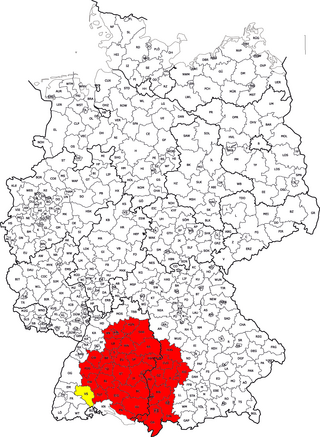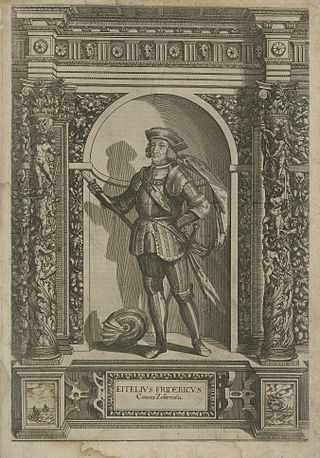
The House of Hohenzollern is a formerly royal German dynasty whose members were variously princes, electors, kings and emperors of Hohenzollern, Brandenburg, Prussia, the German Empire, and Romania. The family came from the area around the town of Hechingen in Swabia during the late 11th century and took their name from Hohenzollern Castle. The first ancestors of the Hohenzollerns were mentioned in 1061.

Albrecht III was Elector of Brandenburg from 1471 until his death, the third from the House of Hohenzollern. A member of the Order of the Swan, he received the cognomen Achilles because of his knightly qualities and virtues. He also ruled in the Franconian principalities of Ansbach from 1440 and Kulmbach from 1464.

Sophie, Duchess of Hohenberg was the wife of Archduke Franz Ferdinand of Austria, the heir to the Austro-Hungarian throne. Their assassination in Sarajevo sparked a series of events that led, four weeks later, to World War I.

Swabia is a cultural, historic and linguistic region in southwestern Germany. The name is ultimately derived from the medieval Duchy of Swabia, one of the German stem duchies, representing the territory of Alemannia, whose inhabitants interchangeably were called Alemanni or Suebi.
Friedrich I of Nuremberg, the first Burgrave of Nuremberg from the House of Hohenzollern. He was the younger son of Count Friedrich II of Zollern, and became Count of Zollern as Friedrich III after the death of his other male relatives.

Bernard I of Baden was Margrave of the Margraviate of Baden from 1391 to 1431.

Sigmaringen Castle was the princely castle and seat of government for the Princes of Hohenzollern-Sigmaringen. Situated in the Swabian Alb region of Baden-Württemberg, Germany, this castle dominates the skyline of the town of Sigmaringen. The castle was rebuilt following a fire in 1893, and only the towers of the earlier medieval fortress remain. Schloss Sigmaringen was a family estate of the Swabian Hohenzollern family, a cadet branch of the Hohenzollern family, from which the German Emperors and kings of Prussia came. During the closing months of World War II, Schloss Sigmaringen was briefly the seat of the Vichy French Government after France was liberated by the Allies. The castle and museums may be visited throughout the year, but only on guided tours. It is still owned by the Hohenzollern-Sigmaringen family, although they no longer reside there.

Frederick I, Count of Zollern, was often cited as a powerful Swabian Count and supporter of the imperial party of Henry V, Holy Roman Emperor.
Johann Georg of Hohenzollern-Hechingen was the first Prince of Hohenzollern-Hechingen.
Karl I of Hohenzollern was Count of Hohenzollern from 1525 to 1575. He was Imperial Archchamberlain and chairman of the Aulic Council.

Count Eitel Friedrich IV of Hohenzollern was the founder and first Count of the line Hohenzollern-Hechingen as Eitel Friedrich I.
Friedrich V of Zollern nicknamed, the Illustrious was a Count of Zollern.

Eitel Friedrich III, Count of Hohenzollern was Count of County of Hohenzollern from 1512 until his death.
Friedrich VI, Count of Zollern, also known as Friedrich the Knight, or Friedrich the Elder, was a Count of Hohenzollern

Eitel Friedrich II, Count of Hohenzollern was a count of Hohenzollern and belonged to the Swabian line of the House of Hohenzollern. He was the first president of the Reichskammergericht. As a close friend of the Archduke and later Emperor Maximilian I, he gained great influence in the imperial politics. He managed to consolidate and expand his own territory.
Friedrich VIII, Count of Zollern, nicknamed Easter Sunday was a Count of Hohenzollern.
Friedrich VII, Count of Zollern was a German nobleman. He was the ruling Count of Zollern from 1298 until his death.
Friedrich IX, Count of Hohenzollern, nicknamed "Fredrick the Old" or "the Black Count", was a German nobleman. He was the ruling count of Hohenzollern from 1339 until his death.
Friedrich XI, Count of Hohenzollern, nicknamed Friedrich the Elder was a German nobleman. He was a member of the House of Hohenzollern and a ruling Count of Hohenzollern-Hechingen.
Albrecht II of Hohenberg-Rotenburg was Count of Hohenberg and Haigerloch and imperial governor of Lower Swabia. He was a member of the house of Zollern-Hohenberg, a branch of the Swabian House of Hohenzollern which split off in the 12th century. Two stanzas in the Codex Manesse are attributed to him under the name of Albrecht von Haigerloch.









